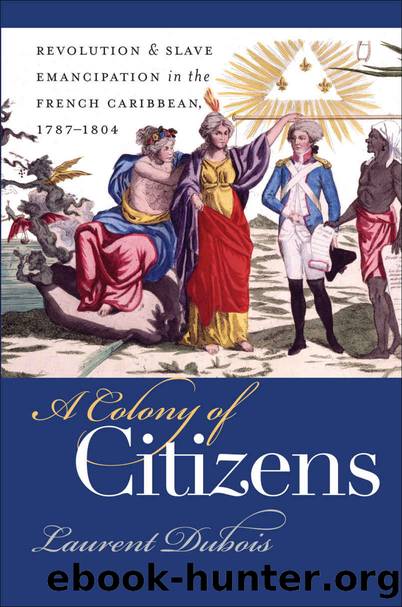A Colony of Citizens (Published by the Omohundro Institute of Early American History and Culture and the University of North Carolina Press) by Dubois Laurent

Author:Dubois, Laurent [Dubois, Laurent]
Language: eng
Format: epub
Publisher: Omohundro Institute and University of North Carolina Press
Published: 2012-11-30T16:00:00+00:00
Citizen-Soldiers
In 1802, General Antoine Richepance blamed the âignoranceâ of the Republican black soldiers for the insurrection he had just defeated. The island of Guadeloupe, he complained, had been âunder the influence of an army made up almost entirely of men with no education, who had not been prepared by any principle for the noble profession of the soldierâ and âwhose passions, needs, and ideas did not go beyond the most vulgar.â Several years before, a Guadeloupean planter griped to the minister: âThe spirit of license that Hugues has excited and fomented among the blacks against the whites is gaining the strength of habit. The blacks compose almost all of the army, and they take advantage of the rarity of whites, although most of them, or nearly all of them, preserve a certain respect for whites, which is a good sign.â The next year he noted that the multiple mutinies among the troops were the result of having only a âsmall number of whitesâ in an army âalmost completely composed of blacks.â 22
Like the âpeopleâs armies,â which had been defending France at the time Victor Hugues left for Guadeloupe, the Republican army of the Caribbean was notable for the rapid promotions it provided soldiers of all social classes. Indeed, military service in the Caribbean opened up social mobility beyond that available in metropolitan France, since slaves who had always been kept outside the legal order were now transformed into the ultimate defenders of a new legal order. The army units formed by Hugues in the mid-1790s, furthermore, were racially integrated and so provided a context for the emergence of new social networks that connected whites and blacks.
Unfortunately, there are few existing sources that provide information about the composition of eastern Caribbean Republican armies. Ãtat civil records from the period, however, provide a window into the lives of soldiers and the diversity of the military units in which they served. From such records we can garner details about the Bataillon des sans-culottes, the first Guadeloupean unit formed by Hugues, which was garrisoned in Basse-Terre in 1795. The captains of the companies included Noël Corbet and Pierre Gédéonâtwo men who would play important roles in the insurrection of 1802âalong with a leper named Jean-Baptiste Vulcain. Vulcain had become an officer thanks to a provision, promulgated by Hugues, through which any man who brought more than twenty recruits to join the army would automatically be named a sergeant. Within a few months he had already risen to the rank of captain and commanded both gens de couleur such as Pierre Boudet and ex-slaves such as Thimothé and Jean-Louis. A native of Basse-Terre, Jean-Louis decided to use his newfound right to documentation to marry another ex-slave named Magdelaine, who lived on a local plantation. His comrade Thimothé, as well as another ex-slave who had become part of the townâs National Guard, were witnesses at the wedding. During January and February 1795, many other members of the Bataillon des sans-culottes similarly rushed to legitimize long-term relationships, and many appeared with a combination of ex-slave and French metropolitan witnesses.
Download
This site does not store any files on its server. We only index and link to content provided by other sites. Please contact the content providers to delete copyright contents if any and email us, we'll remove relevant links or contents immediately.
| Africa | Americas |
| Arctic & Antarctica | Asia |
| Australia & Oceania | Europe |
| Middle East | Russia |
| United States | World |
| Ancient Civilizations | Military |
| Historical Study & Educational Resources |
Magic and Divination in Early Islam by Emilie Savage-Smith;(1498)
Ambition and Desire: The Dangerous Life of Josephine Bonaparte by Kate Williams(1342)
Bohemians, Bootleggers, Flappers, and Swells: The Best of Early Vanity Fair by Bohemians Bootleggers Flappers & Swells- The Best of Early Vanity Fair (epub)(1340)
Papillon by Henry Charrière(1305)
Twelve Caesars by Mary Beard(1250)
Operation Vengeance: The Astonishing Aerial Ambush That Changed World War II by Dan Hampton(1134)
What Really Happened: The Death of Hitler by Robert J. Hutchinson(1126)
London in the Twentieth Century by Jerry White(1110)
Time of the Magicians by Wolfram Eilenberger(1084)
Twilight of the Gods by Ian W. Toll(1082)
The Japanese by Christopher Harding(1081)
Lenin: A Biography by Robert Service(1040)
The Devil You Know by Charles M. Blow(983)
A Social History of the Media by Peter Burke & Peter Burke(935)
Freemasons for Dummies by Hodapp Christopher;(920)
Napolean Hill Collection by Napoleon Hill(898)
Henry III by David Carpenter;(890)
The Churchill Complex by Ian Buruma(879)
The Rise and Triumph of the Modern Self by Unknown(877)
